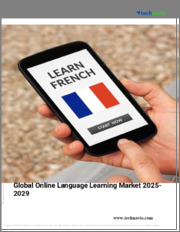
|
시장보고서
상품코드
1518382
온라인 언어 과외 시장 : 학습 모드별, 연령대별, 언어별, 최종 사용자별, 지역별 - 세계 전망(-2030년)Online Language Tutoring Market by Learning Mode (One-on-one, Group), Age Group (<18 Years, 18-20 Years), Language, End User (Individual Learners, Educational Institutes, Government Bodies, Corporate Learners), and Geography - Global Forecast to 2030 |
||||||
이 보고서는 주요 5개 지역의 온라인 언어 과외 시장을 상세하게 분석했으며, 현재 시장 동향, 시장 규모, 시장 점유율, 최근 동향, 2031년까지 예측에 중점을 두어 분석했습니다.
온라인 언어 과외 시장은 2024년부터 2031년까지 20.6%의 연평균 복합 성장률(CAGR)로 성장을 지속하여 2031년까지 154억 달러에 달할 것으로 예상됩니다. 이 시장의 성장은 개인화된 학습 경험에 대한 수요 증가, e러닝의 확대, 온라인 언어 과외 앱의 저렴한 가격 등이 그 배경이 되고 있습니다. 그러나 데이터 보안 및 개인정보 보호에 대한 우려는 시장 확대에 걸림돌이 될 수 있습니다.
회화 연습과 문화 교류를 위해 원어민에게 접근하고자 하는 학습자의 요구가 증가하고, 인터넷과 모바일 사용자 기반이 확대되면서 시장 성장의 기회를 창출할 것으로 예상됩니다. 그러나 언어를 가르칠 수 있는 숙련된 전문가가 부족하고 고속 인터넷/스마트 기기에 대한 접근성이 제한적이라는 점은 이 시장에서 사업을 전개하는 기업들에게 큰 도전이 되고 있습니다. 또한, AI와 적응형 학습의 통합, 온라인 튜터링 세션에 게임화 요소의 통합은 세계 온라인 언어 과외 시장에서 두드러진 추세입니다.
목차
제1장 서론
제2장 조사 방법
제3장 주요 요약
- 시장 개요
- 시장 분석 : 학습 모드별
- 시장 분석 : 연령층별
- 시장 분석 : 언어별
- 시장 분석 : 최종사용자별
- 시장 분석 : 지역별
- 경쟁 분석
제4장 시장 인사이트
- 개요
- 시장 성장에 영향을 미치는 요인
- 성장 촉진요인
- 성장 억제요인
- 기회
- 과제
- 동향
- 밸류체인 분석
제5장 온라인 언어 과외 시장 평가 : 학습 모드별
- 개요
- 맨투맨 학습
- 그룹 학습
제6장 온라인 언어 과외 시장 평가 : 연령층별
- 개요
- 18세 이하
- 18-20세
- 21-30세
- 31-40세
- 40세 이상
제7장 온라인 언어 과외 시장 평가 : 언어별
- 개요
- 영어
- 프랑스어
- 스페인어
- 베이징 말
- 독일어
- 이탈리아어
- 아랍어
- 일본어
- 한국어
- 기타 언어
제8장 온라인 언어 과외 시장 평가 : 최종사용자별
- 개요
- 개인 학습자
- 교육기관
- K-12
- 고등 교육기관
- 정부기관
- 기업 학습자
제9장 온라인 언어 과외 시장 평가 : 지역별
- 개요
- 북미
- 미국
- 캐나다
- 유럽
- 독일
- 영국
- 프랑스
- 이탈리아
- 스페인
- 네덜란드
- 러시아
- 스웨덴
- 룩셈부르크
- 기타 유럽
- 아시아태평양
- 일본
- 중국
- 인도
- 한국
- 싱가포르
- 말레이시아
- 호주 및 뉴질랜드
- 인도네시아
- 베트남
- 기타 아시아태평양
- 라틴아메리카
- 멕시코
- 브라질
- 기타 라틴아메리카
- 중동 및 아프리카
- 사우디아라비아
- 아랍에미리트(UAE)
- 기타 중동 및 아프리카
제10장 세계의 온라인 언어 과외 시장 : 경쟁 구도
- 개요
- 주요 성장 전략
- 경쟁 벤치마킹
- 경쟁 대시보드
- 업계 리더
- 시장 차별화 요인
- 선행 기업
- 신규 기업
제11장 기업 개요
- Berlitz Corporation(U.S.)
- Lesson Nine GmbH(Babble)(Germany)
- EF Education First(Switzerland)
- Preply Inc.(U.S.)
- italki HK Limited(China)
- Rosetta Stone, Inc.(U.S.)
- Varsity Tutors(U.S.)
- Rype, Inc.(U.S.)
- Verbling, Inc.(U.S.)
- Pearson plc(U.K.)
- Verbalplanet.com(U.K.)
- Kesson Group Inc.(Skooli)(Canada)
- iTutorGroup(China)
- Cambly Inc.(U.S.)
- ST Tech Inc.(SkimaTalk)(Japan)
- Starkid Limited(Hong Kong)
- Lingoda GmbH(Germany)
- Small Bridge Inc.(Cafetalk)(Tokyo)
- Ambow Education Holding Ltd.(U.S.)
- Beijing Magic Ears Technology Co., Ltd(China)
- Club Z!Inc.(U.S.)
- Revolution Prep.(U.S.)
- Live Lingua(U.S.)
- Protostar Education(Hong Kong)
- mYngle BV(Netherlands)
- Qkids Teacher(China)
- Vedantu Innovations Private Limited(India)
- TutorMe(U.S.)
- Cambridge University Press(U.K.)
(주 : 주요 5개사의 SWOT 분석을 제공 예정입니다)
제12장 부록
LSH 24.07.30Online Language Tutoring Market Size, Share, Forecast, & Trends Analysis by Learning Mode (One-on-one, Group), Age Group, Language, End User (Individual, Educational, Government Bodies, Corporate Learners), and Geography-Global Forecast to 2031.
The research report titled, 'Online Language Tutoring Market Size, Share, Forecast, & Trends Analysis by Learning Mode (One-on-one, Group), Age Group, Language, End User (Individual, Educational, Government Bodies, Corporate Learners), and Geography-Global Forecast to 2031,' provides in-depth analysis of the online language tutoring market across five major geographies and emphasizes on the current market trends, market sizes, market shares, recent developments, and forecasts till 2031.
The online language tutoring market is projected to reach $15.4 billion by 2031, at a CAGR of 20.6% from 2024 to 2031. The growth of this market is driven by the rising demand for personalized learning experiences, expansion in e-learning, and the affordability of online language tutoring apps. However, concerns regarding data security and privacy could hinder market expansion.
Learners' growing need to access native speakers for conversational practice and cultural exchange, and growing internet & mobile phone user bases are expected to create market growth opportunities. However, the lack of trained professionals to teach languages and limited access to high-speed internet/smart devices are major challenges for the players operating in this market. Additionally, the integration of AI and adaptive learning, and the incorporation of gamification elements in online tutoring sessions are prominent trends in the global online language tutoring market.
The global online language tutoring market is segmented based on learning mode, age group, language, and end user. The study also evaluates industry competitors and analyzes the market at the regional & country levels.
Based on learning mode, the online language tutoring market is segmented into one-on-one learning and group learning. In 2024, the one-on-one learning segment is expected to account for the major share of the online language tutoring market. The segment's large share can be attributed to the increasing demand among learners for one-to-one online tutoring, which enhances engagement, comprehension, and skill improvement. There is also a rising need for highly personalized learning experiences that cater to individual learning paces, specific learning objectives, and the continuous pursuit of self-improvement and skill development by learners. However, the group learning segment is projected to register the highest CAGR during the forecast period.
Based on age group, the online language tutoring market is segmented into <18 years, 18-20 years, 21-30 years, 31-40 years, and >40 years. In 2024, the <18 years segment is expected to account for the largest share of the online language tutoring market. The segment's large share is attributed to the increasing digitization of public schools, the rising number of language learners, a significant increase in smartphone users, the increasing demand for kids' learning apps, the rising popularity of online interactive games for language learning, and the proliferation of e-learning platforms. However, the 18-20 years segment is projected to register the highest CAGR during the forecast period.
Based on language, the online language tutoring market is broadly segmented into English, French, Spanish, Mandarin, German, Italian, Arabic, Japanese, Korean, and other languages. In 2024, the English segment is expected to account for the largest share of the online language tutoring market. The segment's large market share is attributed to the growing number of English language learners worldwide, the increasing emphasis on learning English in schools and educational institutions, the high importance of English in business & professional areas, and the increasing investments in start-ups & small companies teaching English. However, the Mandarin segment is projected to register the highest CAGR during the forecast period.
Based on end user, the online language tutoring market is segmented into individual learners, educational institutes, government agencies, and corporate learners. In 2024, the individual learners segment is expected to account for the largest share of the online language tutoring market. The segment's large share is attributed to the rising adoption of smart devices, along with increasing internet penetration, the emergence of new online learning platforms after the COVID-19 pandemic, the rising adoption of self-learning apps, the surging use of social media platforms, and students' preference for learning at their own pace & flexibility. The segment is also projected to register the highest CAGR during the forecast period.
Based on geography, the online language tutoring market is segmented into North America, Asia-Pacific, Europe, Latin America, and the Middle East & Africa. In 2024, Asia-Pacific is expected to account for the largest share of the online language tutoring market. The large market share of this region is attributed to the increasing demand for language skills for work & collaborations across borders, the high demand for multilingual professionals, the rising adoption of self-learning apps in corporate training programs & language institutes, the increasing demand for flexible and convenient language learning-tutoring options, and the growing popularity of English learning programs in the region. Asia-Pacific is also projected to register the highest CAGR during the forecast period.
Key Players:
The key players operating in the Online Language Tutoring Market are A Berlitz Corporation (U.S.), Lesson Nine GmbH (Germany), EF Education First (Switzerland), Preply Inc. (U.S.), italki HK Limited (China), Rosetta Stone, Inc. (U.S.), Varsity Tutors (U.S.), Rype, Inc. (U.S.), Verbling, Inc. (U.S.), Pearson plc (U.K.), Verbalplanet.com (U.K.), Kesson Group Inc. (Canada), iTutorGroup (China), Cambly Inc. (U.S.), ST Tech Inc. (Japan), Starkid Limited (Hong Kong), Lingoda GmbH (Germany), Small Bridge Inc. (Tokyo), Ambow Education Holding Ltd. (U.S.), Beijing Magic Ears Technology Co., Ltd (China), Club Z! Inc. (U.S.), Revolution Prep. (U.S.), Live Lingua (U.S.), Protostar Education (Hong Kong), mYngle BV (Netherlands), Qkids Teacher (China), Vedantu Innovations Private Limited (India), TutorMe (U.S.), and Cambridge University Press (U.K.).
Key questions answered in the report-
- Which are the high-growth market segments based on learning mode, age group, language, end user, and geography?
- What was the historical market for the online language tutoring market?
- What are the market forecasts and estimates for the period 2024-2031?
- What are the major drivers, restraints, opportunities, and challenges in the online language tutoring market?
- Who are the major players, and what shares do they hold in the online language tutoring market?
- What is the competitive landscape like in the online language tutoring market?
- What are the recent developments in the online language tutoring market?
- What are the different strategies adopted by the major players in the online language tutoring market?
- What are the key geographic trends, and which are the high-growth countries?
- Who are the local emerging players in the online language tutoring market, and how do they compete with the other players?
Scope of the Report:
Online Language Tutoring Market Assessment-by Learning Mode
- One-on-one Learning
- Group Learning
Online Language Tutoring Market Assessment-by Age Group
- <18 Years
- 18-20 Years
- 21-30 Years
- 31-40 Years
- >40 Years
Online Language Tutoring Market Assessment-by Language
- English
- French
- Spanish
- Mandarin
- German
- Italian
- Arabic
- Japanese
- Korean
- Other Languages
Online Language Tutoring Market Assessment-by End User
- Individual Learners
- Educational Institutes
- K-12
- Higher Education
- Government Bodies
- Corporate Learners
Online Language Tutoring Market Assessment-by Geography
- North America
- U.S.
- Canada
- Europe
- Germany
- U.K.
- France
- Italy
- Spain
- Russia
- Poland
- Netherlands
- Belgium
- Sweden
- Austria
- Switzerland
- Finland
- Norway
- Turkey
- Ireland
- Luxembourg
- Rest of Europe
- Asia-Pacific
- China
- Japan
- South Korea
- India
- Indonesia
- Australia & New Zealand
- Taiwan
- Hongkong
- Singapore
- Malaysia
- Vietnam
- Rest of Asia-Pacific
- Latin America
- Brazil
- Mexico
- Rest of Latin America
- Middle East & Africa
- UAE
- Saudi Arabia
- Rest of the Middle East & Africa
TABLE OF CONTENTS
1. Introduction
- 1.1 Market Definition & Scope
- 1.2 Market Ecosystem
- 1.3 Currency & Limitations
- 1.3.1 Currency
- 1.3.2 Limitations
- 1.4 Key Stakeholders
2. Research Methodology
- 2.1 Research Approach
- 2.2 Data Collection & Validation Process
- 2.2.1 Primary Research/Interviews with Key Opinion Leaders from the Industry
- 2.2.2 Secondary Research
- 2.3 Market Sizing and Forecasting Approach
- 2.3.1 Market Estimation Approach
- 2.3.1.1 Bottom-up Approach
- 2.3.1.2 Top-down Approach
- 2.3.1.3 Growth Forecast Approach
- 2.3.2 Market Share Analysis
- 2.3.1 Market Estimation Approach
- 2.4 Assumptions for the Study
- 2.5 Limitations for the Study
3. Executive Summary
- 3.1 Market Overview
- 3.2 Market Analysis, by Learning Mode
- 3.3 Market Analysis, by Age Group
- 3.4 Market Analysis, by Language
- 3.5 Market Analysis, by End User
- 3.6 Market Analysis, by Geography
- 3.7 Competitive Analysis
4. Market Insights
- 4.1 Overview
- 4.2 Factors Affecting Market Growth
- 4.2.1 Drivers
- 4.2.1.1 Increasing Need for a Personalized Learning Experience
- 4.2.1.2 Growing E-learning Market
- 4.2.1.3 Minimal Costs of Online Language Tutoring Apps
- 4.2.2 Restraints
- 4.2.2.1 Data Security & Privacy Concerns
- 4.2.3 Opportunities
- 4.2.3.1 Growing Need to Access Native Speakers for Conversational Practice and Cultural Exchange
- 4.2.3.2 Growing Internet and Mobile Phone User Bases
- 4.2.4 Challenges
- 4.2.4.1 Lack of Trained Professionals for Teaching Languages
- 4.2.4.2 Limited Access to High-speed Internet/Smart Devices
- 4.2.5 Trends
- 4.2.5.1 Integration of AI and Adaptive Learning
- 4.2.5.2 Incorporation of Gamification Elements in Online Tutoring Sessions
- 4.2.1 Drivers
- 4.3 Value Chain Analysis
5. Online Language Tutoring Market Assessment- by Learning Mode
- 5.1 Overview
- 5.2 One-on-one Learning
- 5.3 Group Learning
6. Online Language Tutoring Market Assessment-by Age Group
- 6.1 Overview
- 6.2 <18 Years
- 6.3 18-20 Years
- 6.4 21-30 Years
- 6.5 31-40 Years
- 6.6 >40 Years
7. Online Language Tutoring Market Assessment-by Language
- 7.1 Overview
- 7.2 English
- 7.3 French
- 7.4 Spanish
- 7.5 Mandarin
- 7.6 German
- 7.7 Italian
- 7.8 Arabic
- 7.9 Japanese
- 7.10 Korean
- 7.11 Other Languages
8. Online Language Tutoring Market Assessment-by End User
- 8.1 Overview
- 8.2 Individual Learners
- 8.3 Educational Institutions
- 8.3.1 K-12
- 8.3.2 Higher Education
- 8.4 Government Institutes
- 8.5 Corporate Learners
9. Online Language Tutoring Market Assessment-by Geography
- 9.1 Overview
- 9.2 North America
- 9.2.1 U.S.
- 9.2.2 Canada
- 9.3 Europe
- 9.3.1 Germany
- 9.3.2 U.K.
- 9.3.3 France
- 9.3.4 Italy
- 9.3.5 Spain
- 9.3.6 Netherlands
- 9.3.7 Russia
- 9.3.8 Sweden
- 9.3.9 Luxembourg
- 9.3.10 Rest of Europe
- 9.4 Asia-Pacific
- 9.4.1 Japan
- 9.4.2 China
- 9.4.3 India
- 9.4.4 South Korea
- 9.4.5 Singapore
- 9.4.6 Malaysia
- 9.4.7 Australia & New Zealand
- 9.4.8 Indonesia
- 9.4.9 Vietnam
- 9.4.10 Rest of Asia-Pacific
- 9.5 Latin America
- 9.5.1 Mexico
- 9.5.2 Brazil
- 9.5.3 Rest of Latin America
- 9.6 Middle East & Africa
- 9.6.1 Saudi Arabia
- 9.6.2 UAE
- 9.6.3 Rest of the Middle East & Africa
10. Global Online Language Tutoring Market - Competitive Landscape
- 10.1 Overview
- 10.2 Key Growth Strategies
- 10.3 Competitive Benchmarking
- 10.4 Competitive Dashboard
- 10.4.1 Industry Leaders
- 10.4.1.1 Key Players' Market Rankings
- 10.4.2 Market Differentiators
- 10.4.3 Vanguards
- 10.4.4 Emerging Companies
- 10.4.1 Industry Leaders
11. Company Profiles
- 11.1 Berlitz Corporation (U.S.)
- 11.2 Lesson Nine GmbH (Babble) (Germany)
- 11.3 EF Education First (Switzerland)
- 11.4 Preply Inc. (U.S.)
- 11.5 italki HK Limited (China)
- 11.6 Rosetta Stone, Inc. (U.S.)
- 11.7 Varsity Tutors (U.S.)
- 11.8 Rype, Inc. (U.S.)
- 11.9 Verbling, Inc. (U.S.)
- 11.10 Pearson plc (U.K.)
- 11.11 Verbalplanet.com (U.K.)
- 11.12 Kesson Group Inc. (Skooli) (Canada)
- 11.13 iTutorGroup (China)
- 11.14 Cambly Inc. (U.S.)
- 11.15 ST Tech Inc. (SkimaTalk) (Japan)
- 11.16 Starkid Limited (Hong Kong)
- 11.17 Lingoda GmbH (Germany)
- 11.18 Small Bridge Inc. (Cafetalk) (Tokyo)
- 11.19 Ambow Education Holding Ltd. (U.S.)
- 11.20 Beijing Magic Ears Technology Co., Ltd (China)
- 11.21 Club Z! Inc. (U.S.)
- 11.22 Revolution Prep. (U.S.)
- 11.23 Live Lingua (U.S.)
- 11.24 Protostar Education (Hong Kong)
- 11.25 mYngle BV (Netherlands)
- 11.26 Qkids Teacher (China)
- 11.27 Vedantu Innovations Private Limited (India)
- 11.28 TutorMe (U.S.)
- 11.29 Cambridge University Press (U.K.)
(Note: SWOT analysis for the top 5 companies will be provided.)
12. Appendix
- 12.1 Available Customization
- 12.2 Related Reports



















